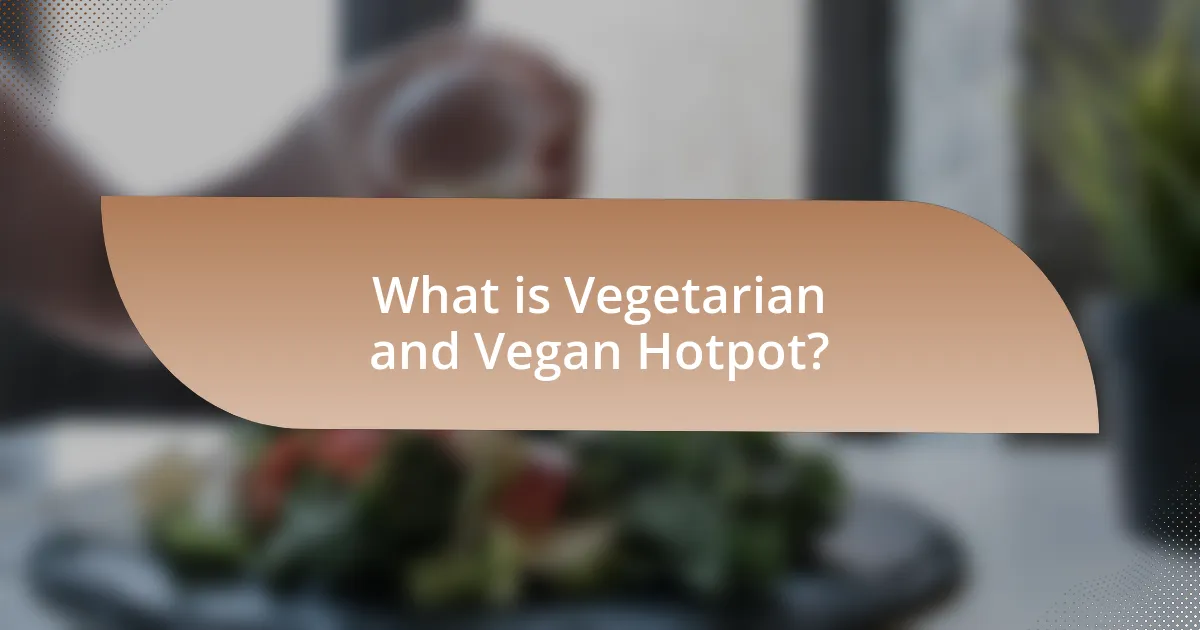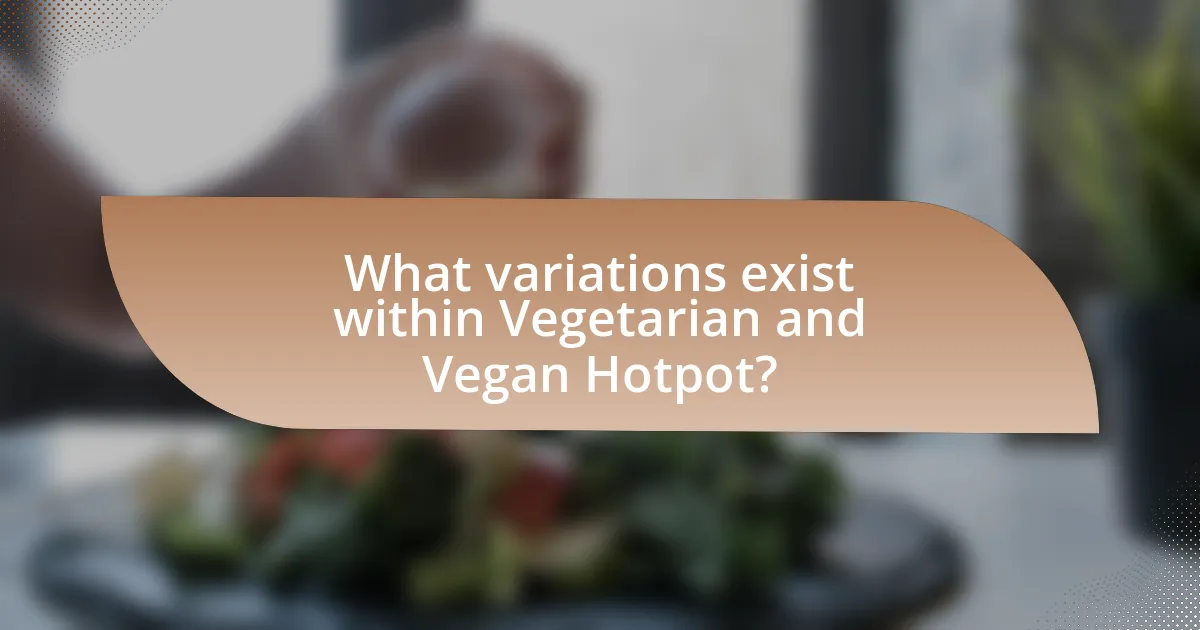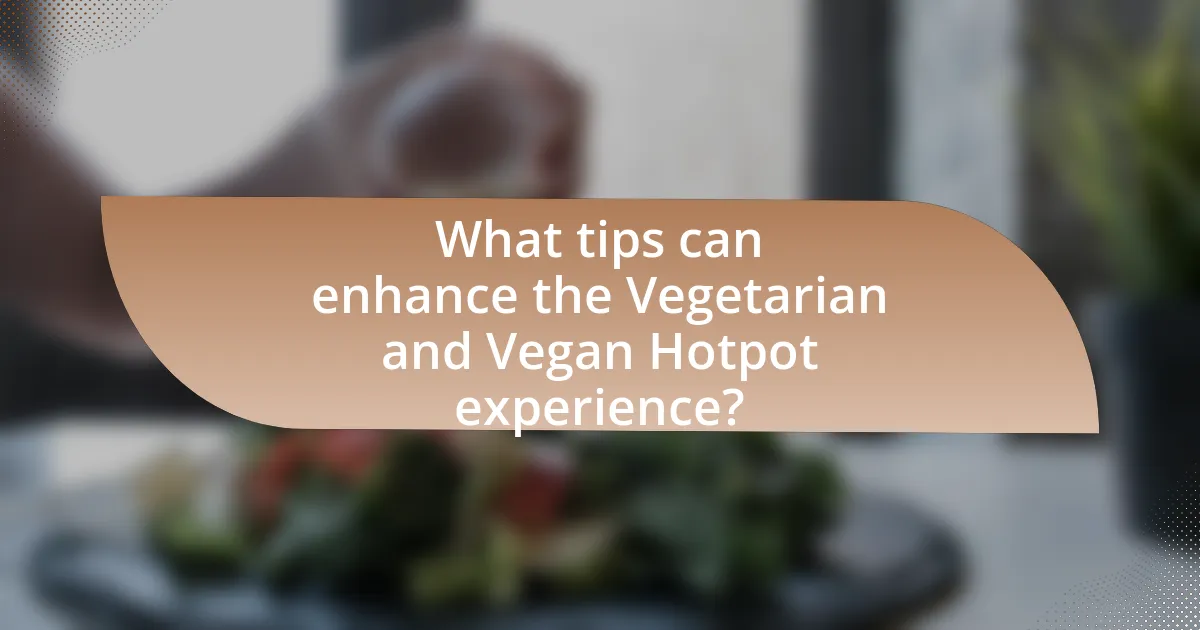Vegetarian and vegan hotpot is a communal dish rooted in Asian cuisine, particularly Chinese culture, that features a simmering pot of plant-based broth accompanied by a variety of vegetables, tofu, mushrooms, and noodles. This article explores the differences between vegetarian and vegan hotpot compared to traditional meat-based versions, highlighting the unique ingredients, cooking methods, and cultural origins that shape these dishes. It also discusses the health benefits associated with plant-based hotpot, including its nutritional advantages, and provides guidance on preparation, ingredient selection, and common pitfalls to avoid. Additionally, the article examines popular recipes, variations across different cuisines, and innovative twists that enhance the hotpot experience.

What is Vegetarian and Vegan Hotpot?
Vegetarian and vegan hotpot is a communal dish that features a simmering pot of broth served with a variety of plant-based ingredients. This culinary style allows diners to cook their own selections of vegetables, tofu, mushrooms, and noodles in the broth, creating a customizable dining experience. The concept of hotpot has roots in Asian cuisine, particularly in Chinese culture, where it is traditionally enjoyed with meat; however, vegetarian and vegan versions cater to those who avoid animal products, making it a popular choice for health-conscious and ethical eaters.
How does Vegetarian and Vegan Hotpot differ from traditional hotpot?
Vegetarian and vegan hotpot differ from traditional hotpot primarily in their ingredients, as vegetarian and vegan versions exclude all animal products. Traditional hotpot typically includes a variety of meats, seafood, and animal-based broths, while vegetarian hotpot uses plant-based ingredients such as vegetables, tofu, and mushrooms, and vegan hotpot eliminates all animal-derived ingredients, including dairy and eggs. This distinction caters to dietary preferences and ethical considerations, reflecting a growing trend towards plant-based eating.
What ingredients are typically used in Vegetarian and Vegan Hotpot?
Vegetarian and vegan hotpot typically includes a variety of vegetables, tofu, mushrooms, and plant-based noodles. Common vegetables used are bok choy, spinach, carrots, and bell peppers, which provide essential nutrients and flavors. Tofu serves as a protein source, while mushrooms like shiitake and enoki add umami depth. Plant-based noodles, such as rice noodles or udon, are often included to enhance the dish’s texture and heartiness. This combination of ingredients creates a nutritious and flavorful meal that aligns with vegetarian and vegan dietary preferences.
How do cooking methods vary for Vegetarian and Vegan Hotpot?
Cooking methods for Vegetarian and Vegan Hotpot primarily differ in the use of ingredients. Vegetarian hotpot may include dairy products like cheese or eggs, while vegan hotpot strictly avoids all animal-derived ingredients. For instance, in vegetarian hotpot, broth can be made with dairy or fish sauce, whereas vegan hotpot requires plant-based broths, often made from mushrooms, seaweed, or vegetables. This distinction necessitates different preparation techniques, such as using non-dairy milk or tofu in vegan recipes, which are not applicable in vegetarian versions.
What are the cultural origins of Vegetarian and Vegan Hotpot?
Vegetarian and Vegan Hotpot has its cultural origins primarily in East Asian cuisine, particularly from China, where traditional hotpot dishes have been enjoyed for centuries. The concept of hotpot involves cooking various ingredients in a communal pot of simmering broth, and while meat-based versions are prevalent, vegetarian and vegan adaptations have emerged to cater to dietary preferences and ethical considerations. The rise of vegetarianism and veganism in modern society has influenced these adaptations, leading to the incorporation of diverse vegetables, tofu, and plant-based broths, reflecting a growing trend towards plant-based diets in many cultures.
Which countries have popularized Vegetarian and Vegan Hotpot?
China and Taiwan have popularized Vegetarian and Vegan Hotpot. In China, particularly in regions like Sichuan and Guangdong, hotpot is a traditional dish that has evolved to include vegetarian and vegan options, catering to the growing demand for plant-based diets. Taiwan is known for its vibrant vegetarian culture, with many restaurants offering vegan hotpot that features a variety of vegetables, tofu, and plant-based broths. The popularity of these dishes is supported by the increasing awareness of health and environmental issues associated with meat consumption, leading to a rise in vegetarian and vegan dining experiences in these countries.
How do cultural practices influence the ingredients used?
Cultural practices significantly influence the ingredients used in vegetarian and vegan hotpot by dictating dietary restrictions, flavor preferences, and ingredient availability. For instance, in Asian cultures, the use of tofu, mushrooms, and various vegetables is prevalent due to historical vegetarianism linked to Buddhism and Taoism, which emphasize compassion towards animals. Additionally, regional ingredients like miso in Japan or lemongrass in Thailand reflect local agricultural practices and culinary traditions. These cultural factors shape not only the selection of ingredients but also the preparation methods, ensuring that the hotpot aligns with the community’s values and tastes.
What health benefits are associated with Vegetarian and Vegan Hotpot?
Vegetarian and vegan hotpot offers numerous health benefits, primarily due to its plant-based ingredients. These hotpots are rich in vitamins, minerals, and antioxidants, which contribute to improved overall health. For instance, a study published in the Journal of Nutrition found that diets high in fruits and vegetables can lower the risk of chronic diseases such as heart disease and diabetes. Additionally, vegetarian and vegan hotpots are typically lower in saturated fats and cholesterol, promoting better heart health. The high fiber content from vegetables and legumes aids in digestion and helps maintain a healthy weight, as supported by research from the American Journal of Clinical Nutrition, which indicates that high-fiber diets are associated with lower body weight and reduced obesity risk.
How does it contribute to a balanced diet?
Vegetarian and vegan hotpot contributes to a balanced diet by providing a variety of nutrients from plant-based ingredients. These hotpots typically include vegetables, legumes, and whole grains, which are rich in vitamins, minerals, fiber, and protein. For instance, legumes like lentils and chickpeas offer essential amino acids and iron, while a diverse array of vegetables adds antioxidants and dietary fiber, promoting digestive health. Research indicates that diets high in plant-based foods can lower the risk of chronic diseases, such as heart disease and diabetes, supporting the notion that vegetarian and vegan options can fulfill dietary needs effectively.
What nutritional advantages does it offer compared to meat-based hotpot?
Vegetarian and vegan hotpot offers several nutritional advantages compared to meat-based hotpot, primarily by being lower in saturated fats and cholesterol while being higher in dietary fiber and essential vitamins. The absence of meat reduces the intake of saturated fats, which are linked to heart disease, while plant-based ingredients provide a rich source of fiber that aids digestion and promotes satiety. Additionally, vegetarian and vegan hotpots often include a variety of vegetables, legumes, and whole grains, which are high in vitamins A, C, and K, as well as minerals like potassium and magnesium, contributing to overall health and well-being. Studies have shown that diets rich in plant-based foods can lower the risk of chronic diseases, further supporting the nutritional benefits of vegetarian and vegan hotpot.
How can one prepare Vegetarian and Vegan Hotpot at home?
To prepare Vegetarian and Vegan Hotpot at home, start by selecting a variety of vegetables such as mushrooms, bok choy, carrots, and tofu as the main ingredients. Next, prepare a flavorful broth using vegetable stock, soy sauce, garlic, and ginger to enhance the taste. Bring the broth to a boil in a pot, then add the vegetables and tofu, allowing them to cook until tender. Serve the hotpot with dipping sauces like sesame sauce or chili oil for added flavor. This method is effective as it allows for customization based on personal preferences and dietary restrictions, making it a versatile dish for various tastes.
What are the essential tools and equipment needed?
The essential tools and equipment needed for preparing a vegetarian and vegan hotpot include a large pot or hotpot cooker, a heat source, cutting boards, knives, and serving utensils. A large pot or hotpot cooker is crucial for simmering the broth and cooking the ingredients evenly. A reliable heat source, such as a stovetop or portable burner, ensures consistent cooking temperatures. Cutting boards and knives are necessary for preparing fresh vegetables, tofu, and other ingredients. Serving utensils, like ladles and tongs, facilitate easy serving and handling of the hotpot contents. These tools collectively enable an efficient and enjoyable cooking experience for vegetarian and vegan hotpot dishes.
What are some popular recipes for Vegetarian and Vegan Hotpot?
Popular recipes for Vegetarian and Vegan Hotpot include Mushroom Hotpot, which features a variety of mushrooms like shiitake and enoki, combined with tofu and seasonal vegetables in a flavorful broth. Another popular option is the Thai Coconut Curry Hotpot, which incorporates coconut milk, lemongrass, and a mix of vegetables such as bell peppers and zucchini, providing a rich and aromatic experience. Additionally, the Spicy Sichuan Hotpot is favored for its bold flavors, using ingredients like tofu, napa cabbage, and a spicy broth made with Sichuan peppercorns and chili oil. These recipes are well-regarded for their ability to deliver satisfying and diverse flavors while adhering to vegetarian and vegan dietary preferences.

What variations exist within Vegetarian and Vegan Hotpot?
Vegetarian and vegan hotpot variations include a range of broths, ingredients, and regional styles. Common broth options for vegetarian hotpot are mushroom, vegetable, and miso, while vegan hotpot often features similar broths but excludes any animal-derived ingredients. Ingredient variations can include tofu, seitan, a variety of vegetables like bok choy and mushrooms, and noodles. Regional styles, such as Chinese, Japanese, and Thai hotpots, introduce unique flavors and preparation methods, enhancing the overall experience. For instance, Sichuan hotpot is known for its spicy broth, while Japanese shabu-shabu emphasizes a lighter, clearer broth.
How do different cuisines interpret Vegetarian and Vegan Hotpot?
Different cuisines interpret Vegetarian and Vegan Hotpot by incorporating local ingredients and flavors while maintaining the essence of a communal cooking experience. For example, in Chinese cuisine, vegetarian hotpot often features a variety of mushrooms, tofu, and seasonal vegetables, served with a rich broth made from vegetable stock and spices. In contrast, Japanese shabu-shabu emphasizes fresh vegetables and plant-based proteins like konjac and tofu, accompanied by dipping sauces such as sesame or ponzu. Indian interpretations may include a spiced broth with lentils and an array of vegetables, reflecting the region’s diverse spices and cooking techniques. Each cuisine adapts the hotpot concept to highlight its unique culinary traditions while ensuring that the dish remains vegetarian or vegan.
What unique ingredients are used in Asian Vegetarian and Vegan Hotpot?
Asian Vegetarian and Vegan Hotpot features unique ingredients such as tofu, various mushrooms, and a wide array of vegetables like bok choy and napa cabbage. Tofu serves as a protein source, while mushrooms like shiitake and enoki add umami flavor. The inclusion of fresh vegetables enhances the nutritional profile and texture of the dish. Additionally, ingredients like rice noodles and plant-based broths, often flavored with miso or spices, contribute to the overall taste experience. These components are integral to creating a satisfying and flavorful hotpot that caters to vegetarian and vegan diets.
How does Mediterranean Vegetarian and Vegan Hotpot differ in preparation?
Mediterranean Vegetarian and Vegan Hotpot differ in preparation primarily through the choice of ingredients and flavor profiles. The vegetarian version typically includes dairy products like cheese or yogurt, while the vegan version excludes all animal products, relying on plant-based alternatives. Additionally, the Mediterranean hotpot emphasizes the use of fresh vegetables, legumes, and grains, with herbs such as oregano and basil for seasoning, which are integral to Mediterranean cuisine. This distinction in ingredient selection directly influences the cooking techniques, where the vegetarian hotpot may involve layering cheese or cream, whereas the vegan hotpot focuses on creating depth of flavor through spices and vegetable stocks.
What are some creative twists on traditional Vegetarian and Vegan Hotpot?
Creative twists on traditional Vegetarian and Vegan Hotpot include using unique broths such as miso-tahini or coconut curry, incorporating diverse ingredients like jackfruit, tempeh, or a variety of mushrooms, and adding international flavors through spices like za’atar or harissa. These variations enhance the traditional hotpot experience by introducing new textures and tastes, making it more appealing to a wider audience. For instance, jackfruit mimics the texture of meat, while miso-tahini broth offers a rich umami flavor, demonstrating how these creative adaptations can elevate the dish beyond its conventional roots.
How can one incorporate fusion elements into the dish?
To incorporate fusion elements into a vegetarian or vegan hotpot, one can blend ingredients and cooking techniques from different culinary traditions. For example, adding miso paste from Japanese cuisine can enhance the umami flavor, while incorporating spices like cumin and coriander from Indian cuisine can introduce warmth and depth. This approach not only diversifies the flavor profile but also creates a unique dining experience that reflects a combination of cultural influences. The use of diverse ingredients, such as tofu, chickpeas, and seasonal vegetables, allows for a creative interpretation of traditional hotpot, making it adaptable to various tastes and dietary preferences.
What innovative ingredients can enhance the flavor profile?
Innovative ingredients that can enhance the flavor profile of vegetarian and vegan hotpot include miso paste, nutritional yeast, and smoked paprika. Miso paste adds umami depth due to its fermentation process, while nutritional yeast contributes a cheesy flavor and is rich in B vitamins. Smoked paprika introduces a subtle smokiness that can elevate the overall taste experience. These ingredients are widely recognized in culinary practices for their ability to transform dishes, making them more flavorful and satisfying.

What tips can enhance the Vegetarian and Vegan Hotpot experience?
To enhance the Vegetarian and Vegan Hotpot experience, focus on using a variety of fresh, seasonal vegetables, high-quality plant-based proteins, and flavorful broths. Incorporating diverse ingredients such as mushrooms, tofu, and leafy greens not only adds texture but also maximizes nutritional value. For instance, shiitake mushrooms provide umami flavor, while leafy greens like bok choy offer essential vitamins. Additionally, experimenting with homemade dipping sauces made from ingredients like sesame paste, soy sauce, and chili oil can elevate the overall taste. Research indicates that a colorful plate with a range of nutrients can improve meal satisfaction and enjoyment, making the hotpot experience more delightful.
How can one select the best ingredients for maximum flavor?
To select the best ingredients for maximum flavor in vegetarian and vegan hotpot, prioritize fresh, seasonal produce, high-quality spices, and umami-rich components. Fresh vegetables like mushrooms, leafy greens, and root vegetables enhance flavor profiles, while spices such as ginger, garlic, and chili add depth. Umami-rich ingredients like miso, soy sauce, and nutritional yeast provide savory notes that elevate the dish. Research indicates that using seasonal ingredients not only improves taste but also ensures optimal nutrient content, as they are harvested at peak ripeness.
What are the best practices for seasoning and broth preparation?
The best practices for seasoning and broth preparation in vegetarian and vegan hotpot involve using a variety of herbs, spices, and umami-rich ingredients to enhance flavor. Start by creating a base with aromatics such as garlic, ginger, and onions, which provide depth. Incorporate ingredients like miso paste, soy sauce, or nutritional yeast to introduce umami, essential for a satisfying broth.
Additionally, using fresh herbs like cilantro, basil, or scallions can elevate the taste profile. Adjust seasoning gradually, tasting as you go, to achieve a balanced flavor. For proof, studies show that umami flavors significantly enhance the overall taste experience, making them crucial in plant-based cooking.
How can one ensure a satisfying dining experience for guests?
To ensure a satisfying dining experience for guests, one should focus on providing high-quality ingredients and a variety of options that cater to different dietary preferences, particularly vegetarian and vegan choices. Research indicates that meals prepared with fresh, seasonal produce enhance flavor and satisfaction, as highlighted in studies on consumer preferences in dining experiences. Additionally, offering customizable hotpot options allows guests to select ingredients that align with their tastes and dietary restrictions, thereby increasing their overall enjoyment.
What common mistakes should be avoided when making Vegetarian and Vegan Hotpot?
Common mistakes to avoid when making Vegetarian and Vegan Hotpot include neglecting to balance flavors, using insufficiently varied ingredients, and failing to prepare a rich broth. Balancing flavors is crucial; a bland broth can lead to an unappealing dish. Using a variety of vegetables, proteins, and noodles enhances texture and taste, preventing monotony. Additionally, a well-prepared broth, often made with umami-rich ingredients like mushrooms or miso, is essential for depth of flavor. These elements are vital for creating a satisfying and enjoyable hotpot experience.
How can overcooking affect the texture of ingredients?
Overcooking can significantly alter the texture of ingredients, often resulting in a mushy or overly soft consistency. For example, vegetables like carrots and zucchini lose their crispness and can become unpalatable when exposed to excessive heat for prolonged periods. This change occurs because overcooking breaks down the cell walls and pectin in plant-based ingredients, leading to a loss of structure. Additionally, proteins in ingredients such as tofu can become tough and rubbery when overcooked, detracting from the intended mouthfeel. These texture changes can negatively impact the overall enjoyment and presentation of vegetarian and vegan hotpot dishes.
What are the pitfalls of ingredient pairing in Vegetarian and Vegan Hotpot?
The pitfalls of ingredient pairing in Vegetarian and Vegan Hotpot include flavor imbalance, texture inconsistency, and nutritional deficiencies. Flavor imbalance occurs when strong-tasting ingredients overpower milder ones, leading to a dish that lacks harmony. For example, pairing bitter greens with sweet vegetables without balancing flavors can result in an unpleasant taste. Texture inconsistency arises when ingredients with vastly different cooking times are combined, causing some components to be overcooked while others remain undercooked, which detracts from the overall experience. Lastly, nutritional deficiencies can occur if the pairing lacks variety, leading to an inadequate intake of essential nutrients. For instance, relying solely on starchy vegetables without incorporating protein sources like tofu or legumes can result in a meal that does not meet dietary needs.










